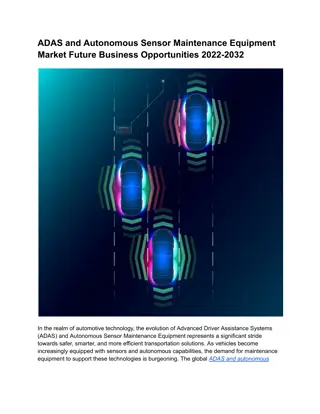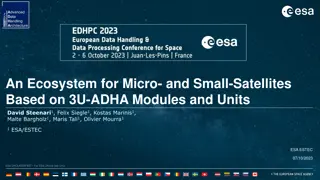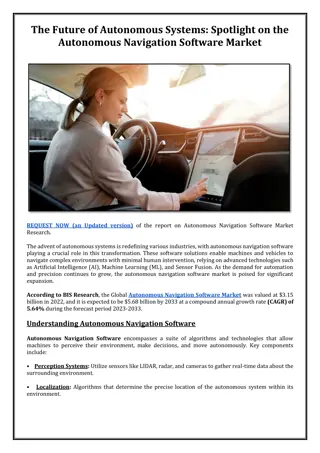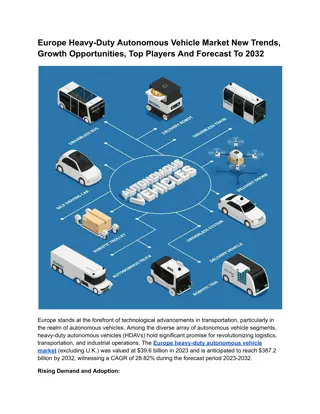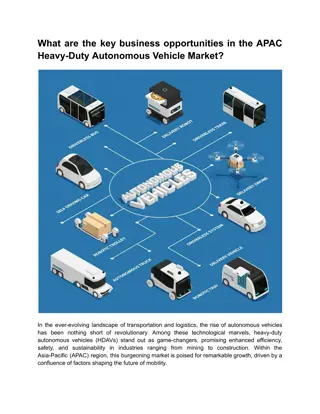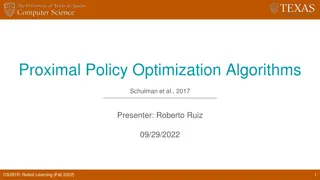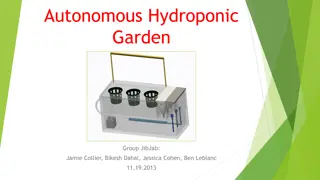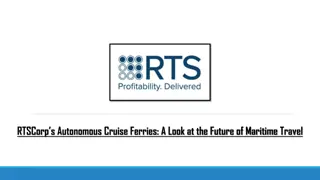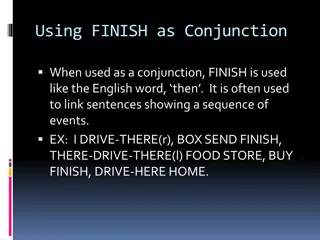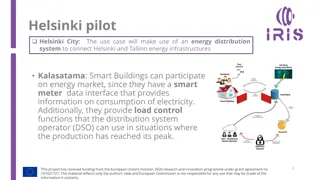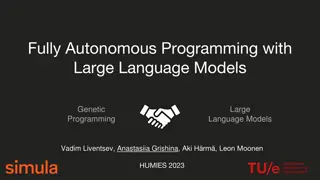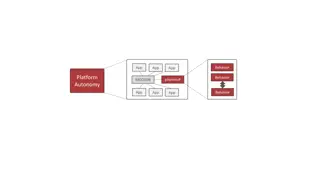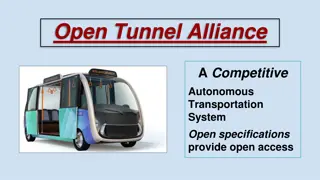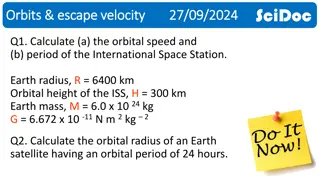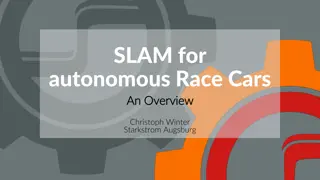Autonomous Conjunction Assessment Methodology Among Satellites
Methodology for Collision Avoidance (CA) among constellations of autonomously-controlled satellites is crucial for protecting assets in space. From straightforward protection against dead satellites to active coordination for maneuverable payloads, the range of primary-secondary CA possibilities is discussed. Autonomous Flight Dynamics (AFD) play a key role in satellite constellations by utilizing precise on-board navigation knowledge and autonomous systems for conjunction assessments and orbit maintenance.
- Autonomous Conjunction Assessment
- Satellite Constellations
- Collision Avoidance
- Autonomous Flight Dynamics
- Space Technology
Download Presentation

Please find below an Image/Link to download the presentation.
The content on the website is provided AS IS for your information and personal use only. It may not be sold, licensed, or shared on other websites without obtaining consent from the author. Download presentation by click this link. If you encounter any issues during the download, it is possible that the publisher has removed the file from their server.
E N D
Presentation Transcript
A Methodology for CA among Constellations of Autonomously-Controlled Satellites NASA Conjunction Assessment Program NASA Small Spacecraft Technology Program SpaceX May 2023 1
Range of Primary-Secondary CA Possibilities From Most to Least Straightforward Protected asset against dead satellite / rocket body / debris Straightforward no need for coordination with secondary, and orbital situation likely to be fairly static Protected asset against non-maneuverable active payload Could inform secondary O/O of maneuvers for situational awareness or as part of good neighbor policy In terms of processing of CA event, can be treated like inert secondary Protected asset against another maneuverable active payload Notwithstanding a prearranged agreement, active coordination now required Secondary may be planning a maintenance maneuver not yet included in its public ephemeris event disappears Secondary may itself be planning a CA RMM not yet included in its public ephemeris Both spacecraft could end up maneuvering into each other Latter situation at present largely to entirely unregularized Relies on good will of both O/Os to establish contact and work out solution O/O point-of-contact information not always easy to locate No machine-to-machine facilitation presently, unless both O/Os subscribe to a private service Even then, such services are at present more communications facilitation than structured conjunction resolution 2
Autonomous Flight Dynamics (AFD) Definition and Basic Explication Locution autonomous satellite constellation used; but usually this is a misnomer, or at least imprecise Question actually centers on data availability to, and machine-executed portions of, flight dynamics process If satellite constellation maintains essentially continuous data exchange with ground node, then irrelevant whether calculations are performed on-board satellite or on ground What is important is the amount of data and coordination available to the flight dynamics decision-making process Starlink uses a form of autonomous flight dynamics When ascending from injection to on-orbit position, satellite follows master trajectory When actual path deviates sufficiently from master trajectory, autonomous system executes correction burns When in on-orbit position, satellite remains within control box When actual position exceeds control box, autonomous system executes correction burns This autonomous approach includes conjunction assessment Large-criteria used for CA screenings gives snapshot of catalogue in broad vicinity of each Starlink satellite CDMs from these screenings made available to autonomous flight dynamics system Leverages precise on-board navigation knowledge to reduce primary covariance for screenings All maneuvers, whether for orbit maintenance or CA, can be first screened against CDM set Identifies any high risk conjunctions and allows replanning 3
CA CONOPS with Autonomous Flight Dynamics (AFD) Using Current 18-19 SDS Screening Authority Fresh screening results received from 18/19 SDS every 8 hours Made available to flight dynamics software For AFD conjunctions with inert secondary objects, no special issues For AFD conjunctions with active secondaries using traditional flight dynamics, situation is manageable but restricted Both O/Os must agree in advance who will bear the maneuver responsibility for all serious conjunctions O/O without maneuver responsibility must refrain from short-turn maneuvers Need to give the system time to receive maneuver ephemeris, conduct screening, and send new CDM set out to O/O with maneuver responsibility Above situation imposes restriction on one of the O/Os Almost always instantiated with AFD system bearing maneuver responsibility For conjunctions between different objects that each use autonomous flight dynamics, situation currently irresolvable Each has CDMs based only on the other s latest published ephemeris; may or may not include intended mitigation Each could be planning a maneuver that results in the two satellites increasing collision risk with each other Such maneuvers could be either CA risk mitigation maneuvers or orbit maintenance maneuvers This issue recognized as latent problem, but no prompting circumstance to date to force consideration/resolution 4
SpaceX Starlink / NASA Starling Colocated Autonomous Constellations now become Reality NASA Starling technology demonstration Constellation of four, 6U cubesats Serendipitously selected rideshare to 550km collocated with Starlink! Able to massage rideshare to place constellation just above Starlink, but presented opportunity to solve aforementioned autonomous vs autonomous CA problem Consortium of involved parties formed to develop and test solution with actual operations Starling Project: obtained funding for extended mission, development of CONOPS, and needed ground node Starlink: participated in CONOPS development and prepped needed data exchange paradigms NASA CAPO: participated in CONOPS development and serving as chief technical advisor for experiment Department of Commerce: participated in project in observer status Formal experiment expected to begin January 2024 and run ~9 months Starling will be lowered to the edge of Starlink to produce regular yellow conjunctions Mitigation threshold of perhaps 1E-05 for both constellations will produce real events to mitigate, with new CONOPS Very high risk events will be monitored manually and perhaps resolved by traditional methods Experiment results will generate detailed report and broad CONOPS recommendations If experiment successful, DOC interested in appropriating CONOPS for their nascent STC system 5
Autonomous CA CONOPS Drivers Emerged during 18 Months of Consortium Discussions Central repository needed to receive, maintain, and screen O/O ephems against each other with low latency Repository maintains the current intended trajectory for each constellation satellite Able to apply trajectory update restrictions, if O/O wishes this Must be extremely low latency perhaps less than one minute between ephemeris submission and CDM return Central authority needed to manage the taking of responsibility for conjunctions Not necessarily by direct assignment, but facilitating the voluntary acceptance by one of the actors Preserves audit trail for conjunctions and conjunction responsibility acceptance Allows regulatory authorities to determine if O/O-accepted rulesets being followed Approach allowing more federation and less centrality more likely to be accepted nationally/internationally Repository API, published to O/Os, will enable rapid automated submission of ephems and conjunction responsibility acceptance 6
CONOPS Ground Node Needed for Rapid Posting and Screening of Predicted Ephemerides Receives each predicted ephemeris update for every satellite in autonomous constellations Screens each ephemeris against all other ephemerides in its database and returns CDMs Extremely low-latency screening essentially on-demand screenings, with CDMs returned within ~1 min Operator preference whether intra-constellation screenings desired (presumption/default is to refrain from this) Could also screen against remainder of catalogue and provide CDMs for that, if catalogue available to ground node (this functionality will be tested with an open source prototype catalog) Updates database with current trajectory for each protected object, according to the following rules If O/O ephem submitted as definitive, updates DB with this ephem, regardless of conjunctions found during screening If O/O ephem submitted as candidate, ephem screened and CDMs returned, but DB not updated Used for speculative screenings, perhaps as part of maneuver planning If O/O ephem submitted as candidate definitive, DB updated with ephem only if no serious conjunctions encountered CDMs returned in either case, either informationally or for corrective purposes Can submit ranked list of ephems; will update with highest ranked ephem that results in clean screening Pc threshold and look-ahead period settable by O/O 7
CONOPS Ground Node Summary Table of Ephemeris Submission Categories, with Commentary Title Explication Commentary Definitive This is my current intended trajectory Non-maneuverable payloads O/Os who do not intend to cooperate with orbital safety O/Os who wish to manage CA responsibility directly with other O/Os, allowing informal agreements; can work well if O/O has low-latency ground comm Exploratory maneuver planning, for either RMMs or orbit maintenance maneuvers Any other situation in which screening results, without accompanying actions, are desired O/Os who want simplicity of less-iterative CA and are willing perhaps to take on more of a maneuver burden to achieve that O/Os with high(er)-latency ground comm and therefore cannot sustain protracted iteration Candidate This is a trajectory I am exploring Candidate Definitive This is a trajectory, or ranked set of trajectories, I will use if one of them yields a clean screening 8
Centralized Conjunction AdjudicationIssues Why can t we have centralized conjunction resolution for everyone? Optimal assignment of maneuver responsibility is difficult Depends on both enduring and specific exigencies of each O/Os situation and the astrodynamics of the encounter First-in, first-out (FIFO) approach is transparent and formally fair, but is suboptimal and can be gamed Whoever can get trajectories in first wins; latecomers trajectories rejected until they bend to existing DB Grounded ultimately on expectation of strong enforcement of rules; this is what incentivizes an O/O to accept centralized authority s gatekeeping role Despite centralized control, ephemeris database will not remain clear of CA conflicts Non-maneuvering satellites state updates will introduce conjunctions with maneuverable ones Maneuverable sats will need to make modifications to accommodate such changes, despite having had their ephemerides accepted Political difficulties with centralized approach Hosting organization needs to be given regulatory authority to direct adjudication of conjunctions Attendant liability issues need to be resolved Centralized approach, although prima facie straightforward, presents many difficulties 9
Collaborative Conjunction Adjudication A centrally-facilitated but bilaterally-resolved approach When the ground node identifies a conjunction between ephemerides in its DB, alert sent to both O/Os CDM accompanies alert to provide basic astrodynamics information and other event details O/Os can choose from among three categories to indicate their posture toward this collision None: neither O/O has accepted or rejected responsibility for mitigating event Claimed: an O/O has accepted responsibility for mitigating event A new ephem will be submitted shortly that mitigates the conjunction and does not introduce fresh conjunctions The other O/O can (and should) maintain its current planned trajectory and should NOT alter it for this conjunction When new ephem submitted, conjunction event will be removed from manifest Accepted: an O/O has rejected responsibility for mitigating event Standing situation for non-maneuverable satellites Satellite anomaly or other problems could precipitate this Conjunction might be outside of satellite response window cannot respond sufficiently quickly Expected that O/Os could embrace general rules for managing the assignment of responsibility, while allowing specific bilateral arrangements between pairs of O/Os 10
Collaborative Conjunction Adjudication Further Supporting Arguments Insulates against outages or other communication breakdowns Ruleset could indicate O/O #1 supposed to mitigate, but O/O #1 may not receive message or have other issues With current proposal, ground node makes explicit whether O/O #1 actively plans to mitigate conjunction Allows bilateral modification of standard rules Thus enables particular solutions for problems that exist largely between two constellations, such as deorbit of OneWeb satellites through Starlink constellation Eliminates need for ground node to take cognizance of bilateral rulesets, which would be both cumbersome and perhaps not possible (if bilateral arrangement would require functionality modifications to ground node) Promotes paradigm of ex post facto audit rather than ante factum direct enforcement Each O/O can follow the licensing rules of its particular governing authority; ground node can make available historical performance data to allow authority to assess compliance Much more amenable to multinational collaborative paradigm 11
CONOPS Development Past and Future Events vis- -vis Starlink/Starling Experiment Discussions among NASA and SpaceX principals over 18-month period Number of different proposals entertained; present set emerged as most desirable overall Approach has sustained Starling formal reviews (e.g., Critical Design Assessment in Feb 23) Public event (e.g., workshop) contemplated to present approach in more detail and solicit feedback Ability to make major changes for upcoming experiment limited, but all feedback helpful in crafting durable proposal for US DOC to consider Work will pause this summer as Starling staff focuses on main part of mission (Starling 1.0) Will re-engage late this calendar year in preparation for CA part of experiment (Starling 1.5) Experiment to be conducted Jan-Sep 2024 Results of experiment, and finalized recommended CONOPS, will be broadly circulated once available (probably fall/winter 2024) 12



![[PDF⚡READ❤ONLINE] Neptune: The Planet, Rings, and Satellites](/thumb/21522/pdf-read-online-neptune-the-planet-rings-and-satellites.jpg)



